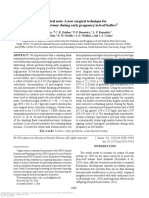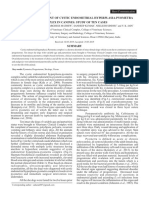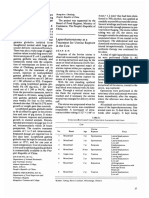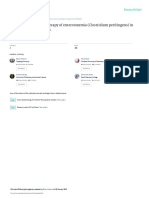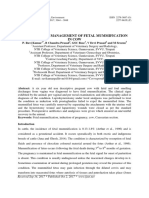Jurnal 1
Jurnal 1
Uploaded by
Yulis Indah Aristyani SuyonoCopyright:
Available Formats
Jurnal 1
Jurnal 1
Uploaded by
Yulis Indah Aristyani SuyonoOriginal Description:
Copyright
Available Formats
Share this document
Did you find this document useful?
Is this content inappropriate?
Copyright:
Available Formats
Jurnal 1
Jurnal 1
Uploaded by
Yulis Indah Aristyani SuyonoCopyright:
Available Formats
See discussions, stats, and author profiles for this publication at: https://www.researchgate.
net/publication/322626206
Correction and management of uterine prolapse in a Holstein Friesian cow
Article · December 2017
CITATIONS READS
0 288
4 authors, including:
Pranab Paul Saroj Kumar Yadav
Chittagong Veterinary and Animal Sciences University Chittagong Veterinary and Animal Sciences University
11 PUBLICATIONS 1 CITATION 23 PUBLICATIONS 11 CITATIONS
SEE PROFILE SEE PROFILE
Tanjila Hasan
Chittagong Veterinary and Animal Sciences University
24 PUBLICATIONS 2 CITATIONS
SEE PROFILE
Some of the authors of this publication are also working on these related projects:
Multiplex PCR System for Rapid Identification of Bacterial Pathogens from Goats Presumed with Fever and Diarrhoea View project
Determination of the level of resistance and strategic plan of using common antibiotic in different species in TVH, CVASU View project
All content following this page was uploaded by Saroj Kumar Yadav on 20 January 2018.
The user has requested enhancement of the downloaded file.
Asian Australas. J. Biosci. Biotechnol. 2017, 2 (3), 251-254
Asian-Australasian Journal of
Bioscience and Biotechnology
ISSN 2414-1283 (Print) 2414-6293 (Online)
www.ebupress.com/journal/aajbb
Short Communication
Correction and management of uterine prolapse in a Holstein Friesian cow
Pranab Paul1, Md. Monir Hossan2, Saroj Kumar Yadav1 and Tanjila Hasan1*
1
Department of Medicine and Surgery, Faculty of Veterinary Medicine, Chittagong Veterinary and Animal
Sciences University, Khulshi, Chittagong-4225, Bangladesh
2
Veterinary surgeon, Manikganj Sadar, Manikganj, Bangladesh
*Corresponding author: Tanjila Hasan, Department of Medicine and Surgery, Faculty of Veterinary Medicine,
Chittagong Veterinary & Animal Sciences University, Khulshi, Chittagong-4225, Bangladesh. Phone:
+8801735509192; Fax: +880-031-659620; E-mail: tanjila.cvasu@gmail.com
Received: 22 October 2017/Accepted: 03 December 2017/ Published: 31 December 2017
Abstract: A three years old Holstein Friesian (HF) cow with a history of premature calving was brought to the
clinics of Veterinary college and Research Institute, Nammakal. The cow showed protrusion of mass through
the vulva after its first calving. On clinical examination animal was apparently healthy and confirmed as uterine
prolapse. The Uterine prolapse was corrected manually following proper precautionary measures. To prevent
the recurrence, Buhner’s suture was applied. Animal had an uneventful recovery.
Keywords: Holstein Friesian cow; uterine prolapse; buhner’s suture
1. Introduction
Uterine prolapse is the protrusion of the uterus from the vulva with the mucosal surface exposed (Gustafsson et
al., 2004; Kornmatitsuk et al., 2004). Uterine prolapse occurs most often immediately after parturition and
occasionally up to several hours afterward. The presence of a part of the fetal membrane in the genital passage
induces strong tenesmus and prolapse. Various predisposing factors have been suggested for uterine prolapse
in the cow, e.g. hypocalcaemia, prolonged dystocia, fetal traction, fetal oversize, retained fetal membranes,
chronic disease and paresis (Risco et al., 1984; Reynolds et al., 1984; Ishii et al., 2010; Aoki et al., 2010).
Prolapse of the uterus at post parturient period through the genital passage and it’s expulsion outside the body is
a frequent sequel to protracted dystocia. Uterine prolapse has been recorded in all species of animal, although
most commonly seen in pluriparous dairy cows occurring immediately after parturition and occasionally after
several hours (Roberts, 1971; Simon et al., 2015). Incidence of post partum uterine prolapse varies from 6.6 %
to 12.9 % (Nanda and Sharma, 1982). In the period immediately after prolapse the tissues appear almost normal,
but within a few hours they become enlarged and edematous. Some animals will develop hypovolaemic shock,
secondary to internal blood loss, laceration of the prolapsed organ or incarceration of abdominal viscera
(Ramsingh et al., 2013; Mohan et al., 2013). It is regarded as a veterinary emergency because without treatment,
the cow is likely to die (Murphy and Dobson, 2002; Miesner and Anderson, 2008). The method of raising the
rear end of the cow using a tractor was reported as a quick, easy and essentially practical method of dealing with
a prolapsed uterus (Ishii et al., 2010; Aoki et al., 2010). This case report describes the successful correction of
uterine prolapse in a cow.
2. Case presentation & history
The three years old primiparous HF cow was presented with history of protrusion of mass through the vulva
since seven hours after parturition. She delivered a male calf. On gynaeco-clinical examination the cow was
apparently healthy with moderate tenesmus and the physiological parameters were within the normal range. The
prolapsed mass was larger, longer (hanging down to the hocks when standing) (Figure 1), more deep red in
Asian Australas. J. Biosci. Biotechnol. 2017, 2 (3) 252
colour and covered with foetal membranes. The prolapsed mass was also edematous, engorged and soiled with
faeces, straw, dirt and blood clots.
3. Surgical management
a. General approach
Before to the treatment physical examination was done and recorded the temperature, pulse rate, respiration rate,
body weight etc. Blood sample was collected for the estimation of hemoglobin, ESR, total count of RBC, total
count of WBC, PCV, lymphocyte, neutrophil, eosinophil, monocyte, basophil, serum calcium, serum
magnesium, serum phosphorus, S.GOT and S.GPT.
b. Correction of uterine prolapse
Caudal epidural anesthesia was done with 5ml 2% lignocaine HCl for prevention of straining. Then the partial
foetal membrane was carefully separated avoiding damage to maternal caruncles and bleeding. The tissue debris
was removed by washing and cleaning the prolapsed mass with water (Figure 2). The prolapsed mass was
thoroughly irrigated with 1:1000 potassium permanganate solutions (Figure 3). With gloved and lubricated
hand, the everted uterus was pushed through the vagina by manual pressure to regain its normal position (Figure
4 and Figure 5). To prevent further complications, intrauterine four Furea boli were kept in uterus. Re-occurance
of prolapse due to tenesmus was prevented by applying Buhner’s suture (Figure 6). The suture was removed
after 14 days. The cow recovered uneventfully without any complications (Figure 7).
c. Post operative care
Calcium borogluconate solution [45ml, intravenously], antibiotic [Streptopenicillin, 7.5ml, intramuscularly],
antihistaminic [20ml, intramuscularly] and dextrose saline [(20%) 2000ml, intravenously] were injected for 7
days.
3. Results and Discussion
The cow showed good recovery without recurrence and other complications. The suture was removed after two
weeks. The incidence of uterine prolapse registered frequently in cattle and sheep (Bhattacharyya et al., 2012;
Fazili et al., 2012). It is generally noticed during immediately post-partum especially after dystocia (Sah and
Nakao, 2003). But in the reported case, the prolapse was observed in HF cow after normal parturition of a male
calf. The objective in the treatment of uterine prolapse was replacement of the organ to its original position and
prevention of recurrence. The usual sequel of uterine prolapse is haemorrhage, shock, septic metritis, peritonitis,
infertility or death. Bhattacharya et al. (2012) reported 9.09% mortality rate and 18.18% cows developed
metritis. However, careful removal of dung and dirt materials using potassium permanganate solution prevented
the uterine infection in this case as noticed by Simon et al. (2015) and Gupta et al. (2015). Elevation of hind
quarters helps in repositioning of prolapsed uterus with good recovery rate (Ishii et al., 2010; Aoki et al., 2010).
It was observed that the hygienic handling, proper management and treatment should definitely prevent further
reproductive tract damage and aid in quick recovery.
In this case hematological parameter showed low serum calcium level (7.5 mg/dl) (Table 1) indicating
hypocalcaemia. Decreased level of calcium can lead to reduced vaginal and uterine muscle tone which
predisposes the animal to prolapse (Noakes et al., 2009). Based on the results of the present study, deficiency of
calcium (7.5 mg/dl), magnesium (1.6 mg/dl) and phosphorus (3.2mg/dl) might be the possible factor that leads
to prolapse of genital track in cow. Besides biochemical observation, the blood sample was also tested to detect
different blood parameters (Table 2). The result showed that there was increased level of ESR (12 mm in 1st
hour) and decreased PCV (22%). According to Jain (1986), ESR increases in inflammatory conditions and in
acute generalized infection. This result is in agreement with those of Kinney (1967), who stated that the
decrease in PCV in prolapsed animals might be due to possible release of antidiuretic hormone as a result of
stress.
Table 1. Biochemical blood analysis in cow suffering from uterine prolapse.
Name of the test Result Normal Range
Serum calcium 7.5 9.7-12.4 mg/dl
Serum magnesium 1.6 1.8-2.3 mg/ dl
Serum phosphorous 3.2 5.6-6.5 mg/dl
Asian Australas. J. Biosci. Biotechnol. 2017, 2 (3) 253
Table 2. Routine blood test in cow suffering from uterine prolapse.
Name of the test Result Normal Range
Hemoglobin 8 8-15 gm%
ESR (Wintrobe tube method) 12 6-10 (mm in 1st hour)
Total count of RBC 5 5-10 million/ cumm
Total count of WBC 6 4-12 thousand/ cumm
PCV 22 24-46%
Lymphocytes 72 45-75%
Neutrophils 25 15-45%
Eosinophils 6 0-20%
Monocytes 3 2-7%
Basophils 1 0-2%
Figure 1. Hanging prolapsed Figure 2. Cleaning the prolapsed mass
uterus. with water.
Figure 3. Application of potash Figure 4. Application of lubricant in
water in the uterine mass. the uterine mass.
Figure 5. Repositioning the Figure 6. Applying Buhner’s
prolapsed mass. suture.
Asian Australas. J. Biosci. Biotechnol. 2017, 2 (3) 254
Figure 7. Recovered cow.
4. Conclusions
Uterine prolapse may appear in peri-parturient period. Diagnosis and treatment of uterine prolapse is very much
important task. Delayed in correction may cause some critical condition such as edema, fibrosis, necrosis,
septicemia. So the farmers and veterinarians should be careful about early recovery of the condition which will
save the cow from life-threatening condition.
Acknowledgements
Authors are thankful to the Director of Teaching Veterinary Hospital, Chittagong Veterinary and Animal
Science University and All the members of Veterinary college and Research Institute, Nammakal for providing
necessary facilities to this case study.
Conflict of interest
None to declare.
References
Bhattacharyya HK, MR Fazili, BA Buchoo and AH Akand, 2012. Genital prolapse in crossbred cows:
prevalence, clinical picture and management by a modified Bühner’s technique using infusion (drip) set
tubing as suture material. Veterinarski arhiv., 82: 11-24.
Gustafsson H, B Kornmatitsuk, K Königsson and H Kindahl, 2004. Peripartum and early post partum in the
cow-physiology and pathology. Medicine Vet. OPQ., 34: 64-65.
Ishii M, T Aoki, K Yamakawa, T Uyama, S El-khodery, M Matsui and Y Miyake, 2010. Uterine prolapse in
cows: Effect of raising the rear end on the clinical outcomes and reproductive performance. Veterinarni
Medicina, 55: 113-118.
Jain N, 1986. Schalm’s Veterinary Haematology 4th edition (ed NC Jain) Lea and Febiger, Philadelphia.
Kinney JM, 1967. The effect of injury on metabolism. Br. J. Surg., 54: 435-437.
Miesner MD and DE Anderson, 2008. Management of uterine and vaginal prolapse in the bovine. Vet. Clin.
North Am. Food Anim. Pract., 24: 409-419.
Murphy A and H Dobson, 2002. Predisposition, subsequent fertility, and mortality of cows with uterine
prolapse. Vet. Rec., 151: 733-735.
Nanda AS and RD Sharma, 1982. Incidence and etiology of pre-partum prolapse of vagina in buffaloes. Indian
J. Dairy Sci., 35: 168- 171.
Ramsingh L, KM Mohan and KS Rao, 2013. Correction and management of uterine prolapse in crossbred cows.
Int. J. Agris. Sci. & Vet. Med., 1: 1-3.
Risco CA, JP Reynolds and D Hird, 1984. Uterine prolapse and hypocalcemia in dairy cows. J. Am. Vet. Med.
Assoc., 185: 1517-1519.
Roberts S, 1971. Veterinary Obstetrics and Genital Diseases, 2nd edn, the author. Ithaca, New York, pp. 114.
Sah SK and T Nakao, 2003. Some characteristics of vaginal prolapse in Nepali buffaloes. J. Vet. Med. Sci., 65:
1213-1215.
Simon MS, C Gupta, H Prabhavathy, R Ramprabhu, N Pazhanivel and S Prathaban, 2015. Post-Partum Uterine
Prolapse in a Doe and its Management. Indian Vet. J., 92: 68-69.
View publication stats
You might also like
- Case 28 UVa Hospital System The Long Term Acute Care Hospital ProjectDocument6 pagesCase 28 UVa Hospital System The Long Term Acute Care Hospital Projecthnooy50% (2)
- Section 1: Internal Medicine: John Murtagh Subjectwise DivisionDocument13 pagesSection 1: Internal Medicine: John Murtagh Subjectwise DivisionJohnny Teo25% (4)
- Manual of Methods For Preservation of Valuable Equine GeneticsDocument74 pagesManual of Methods For Preservation of Valuable Equine GeneticsThe Livestock ConservancyNo ratings yet
- 2017 Cecal Dilatationand Distentionandits Managementinacowand Kankayam BullockDocument4 pages2017 Cecal Dilatationand Distentionandits Managementinacowand Kankayam BullockDrAmit KajalaNo ratings yet
- A Case of Retained Placenta in A Dairy Cow: December 2016Document4 pagesA Case of Retained Placenta in A Dairy Cow: December 2016Andi HasrawatiNo ratings yet
- Pyometra in A Cat: A Clinical Case Report: November 2021Document7 pagesPyometra in A Cat: A Clinical Case Report: November 2021Ronny Alberto GallegoNo ratings yet
- Canine Pyometra: Current Perspectives On Causes and Management - A ReviewDocument6 pagesCanine Pyometra: Current Perspectives On Causes and Management - A ReviewLuz RamirezNo ratings yet
- PYOMETRAINAJERSEYDocument4 pagesPYOMETRAINAJERSEYNur Amira SyahirahNo ratings yet
- Canine Pyometra - Current Perspectives On Causes and ManagementDocument6 pagesCanine Pyometra - Current Perspectives On Causes and ManagementFelipe GonzalezNo ratings yet
- Somatic Cell Count and Type of Intramammary Infection Impacts Fertility in Vitro Produced Embryo TransferDocument6 pagesSomatic Cell Count and Type of Intramammary Infection Impacts Fertility in Vitro Produced Embryo TransferalineNo ratings yet
- Esmaeili 2010Document4 pagesEsmaeili 2010asepNo ratings yet
- Nueva Tec Ovh VacasDocument8 pagesNueva Tec Ovh VacasAndres Luna MendezNo ratings yet
- Vet ArhivgenitalprolapseDocument15 pagesVet ArhivgenitalprolapsefrankyNo ratings yet
- Surgical Management of Cystic Endometrial Hyperplasia-Pyometra Complex in Canines: Study of Ten CasesDocument2 pagesSurgical Management of Cystic Endometrial Hyperplasia-Pyometra Complex in Canines: Study of Ten CasesAllison MuñizNo ratings yet
- A Simple Technique For Ovariohysterectomy in The CatDocument9 pagesA Simple Technique For Ovariohysterectomy in The Catalfi fadilah alfidruNo ratings yet
- RJVP 5 4 40-43Document4 pagesRJVP 5 4 40-43ELYNo ratings yet
- M BabuetalDocument9 pagesM Babuetalsimon alfaro gonzálezNo ratings yet
- vms3 501Document6 pagesvms3 501mada yudistiraNo ratings yet
- 521-Article Text-1862-2-10-20231223Document9 pages521-Article Text-1862-2-10-20231223Elma AriyaniNo ratings yet
- Diagnosis and Treatment of Traumatic Reticulitis Associated With Abomasal Obstruction in Beef Cattle During Late Pregnancy: A Case ReportDocument7 pagesDiagnosis and Treatment of Traumatic Reticulitis Associated With Abomasal Obstruction in Beef Cattle During Late Pregnancy: A Case ReportGabrielyNo ratings yet
- Clinicopathologic Findings and Treatment of Bovine ActinomycosisDocument15 pagesClinicopathologic Findings and Treatment of Bovine ActinomycosisKenesaNo ratings yet
- Clinical Management of Hydrallantois Due To Fetal Meningocele in A Non Discritive CowDocument8 pagesClinical Management of Hydrallantois Due To Fetal Meningocele in A Non Discritive CowAnielo Mantilla PierantozziNo ratings yet
- IJAH - Teat SpiderDocument2 pagesIJAH - Teat SpiderSamit NandiNo ratings yet
- Management of Dystocia Due To Fetal Ascites in Holstein Friesian Cross Breed Cow - Case ReportDocument4 pagesManagement of Dystocia Due To Fetal Ascites in Holstein Friesian Cross Breed Cow - Case ReportAam ArahmanNo ratings yet
- Intra Partum ConditionsDocument19 pagesIntra Partum ConditionsMittu KurianNo ratings yet
- Ovinos PDFDocument3 pagesOvinos PDFAndrea Lorena TutaNo ratings yet
- Management of Fetal Dystocia in Ewe: A Case Report: July 2015Document5 pagesManagement of Fetal Dystocia in Ewe: A Case Report: July 2015Kazi Zihadul AlamNo ratings yet
- Feline Pyometra and Its Surgical Management: A Case: Received: 30.03.2021 Accepted: 13.04.2021Document5 pagesFeline Pyometra and Its Surgical Management: A Case: Received: 30.03.2021 Accepted: 13.04.2021dewaNo ratings yet
- Diagnosis and Surgical Management of Prostatic Abscess in A DogDocument4 pagesDiagnosis and Surgical Management of Prostatic Abscess in A DogPutri Nadia ReskiNo ratings yet
- Growth Performance and Survival of Guppy (Poecilia Reticulata) Different Formulated Diets Effect44-1477572136Document8 pagesGrowth Performance and Survival of Guppy (Poecilia Reticulata) Different Formulated Diets Effect44-1477572136Clara LiemNo ratings yet
- 1 PBDocument7 pages1 PBKuntum KhoiraniNo ratings yet
- Vetmed - Vet 201511 0003Document8 pagesVetmed - Vet 201511 0003Aida GlavinicNo ratings yet
- Agasaca (Canine Apocrine Gland Anal AdenocarcinomaDocument7 pagesAgasaca (Canine Apocrine Gland Anal Adenocarcinomabia.airamNo ratings yet
- Jurnal 1Document7 pagesJurnal 1nora cyeanirNo ratings yet
- Atresia Ani CalfDocument5 pagesAtresia Ani CalfNancyNo ratings yet
- Gynaecological Problems in She Dogs: April 2019Document9 pagesGynaecological Problems in She Dogs: April 2019Deana Laura SanchezNo ratings yet
- Non-Surgical Management of Dystocia Due To Sternopagus Twin Monster in Buffalo (Bubalus Bubalis)Document3 pagesNon-Surgical Management of Dystocia Due To Sternopagus Twin Monster in Buffalo (Bubalus Bubalis)Anielo Mantilla PierantozziNo ratings yet
- Fe To To My An Obstetrical Operation To Resolve TheDocument6 pagesFe To To My An Obstetrical Operation To Resolve TheSeptiani Sari SavitriNo ratings yet
- Unihorn Pyometra in A BitchDocument5 pagesUnihorn Pyometra in A BitchIndian Journal of Veterinary and Animal Sciences RNo ratings yet
- Uterine RuptureDocument3 pagesUterine RuptureAndreaAlexandraNo ratings yet
- Pharmacological Aspect of Linum Usitatissimum: Flax Ingestion On Hair Growth in RabbitsDocument5 pagesPharmacological Aspect of Linum Usitatissimum: Flax Ingestion On Hair Growth in Rabbitsdhafer alhaidaryNo ratings yet
- Laparohysterectomy Uterine: ImmunoefficiencyDocument2 pagesLaparohysterectomy Uterine: ImmunoefficiencyAdheSeoNo ratings yet
- Repeat BreedingDocument44 pagesRepeat BreedingIshfaq LoneNo ratings yet
- 1576172679VSRR 6 1 7-13Document8 pages1576172679VSRR 6 1 7-13Harold Daniel Duarte VargasNo ratings yet
- Analisis Proteomico Glandula MamriaDocument14 pagesAnalisis Proteomico Glandula MamriaRita TamasaukasNo ratings yet
- My ThesisDocument144 pagesMy ThesisHendroNo ratings yet
- 1 s2.0 S0093691X20303538 MainDocument11 pages1 s2.0 S0093691X20303538 MainRo BellingeriNo ratings yet
- Therapeutic Management of Clinical Mastitis in A Murrah Buffalo: A Case ReportDocument4 pagesTherapeutic Management of Clinical Mastitis in A Murrah Buffalo: A Case ReportTJPRC PublicationsNo ratings yet
- HidrometraDocument3 pagesHidrometraSéforaNo ratings yet
- Management of Feline Idiopathic Cystitis (FIC) Using Probiotic Combination TreatmentDocument4 pagesManagement of Feline Idiopathic Cystitis (FIC) Using Probiotic Combination TreatmentMelita Nono LebangNo ratings yet
- BacterialisolationDocument10 pagesBacterialisolationMark SudieNo ratings yet
- Prevalence and Chemotherapy of Enterotoxemia (Clostridium Perfringens) in Diarrheic Sheep and GoatsDocument12 pagesPrevalence and Chemotherapy of Enterotoxemia (Clostridium Perfringens) in Diarrheic Sheep and GoatsErnesto VersailleNo ratings yet
- Al-Hamdani2017 2Document9 pagesAl-Hamdani2017 2namratahans786No ratings yet
- Homepage: - : IntroductionDocument7 pagesHomepage: - : IntroductionIJAR JOURNALNo ratings yet
- Pone 0106663 PDFDocument14 pagesPone 0106663 PDFJUDITH ABANTO BRIONESNo ratings yet
- Application of MisoprostolDocument6 pagesApplication of MisoprostolDiogo DutraNo ratings yet
- Surgical Management of Obstructive Urolithiasis in Small Ruminants by Tube Cystostomy in Chittagong, BangladeshDocument11 pagesSurgical Management of Obstructive Urolithiasis in Small Ruminants by Tube Cystostomy in Chittagong, BangladeshDavid Julian ClavijoNo ratings yet
- Pyometra in A Cat: A Clinical Case Report: Research ArticleDocument6 pagesPyometra in A Cat: A Clinical Case Report: Research ArticleFajarAriefSumarnoNo ratings yet
- 27-Vcsarticle 5Document2 pages27-Vcsarticle 5Vet Fazal BuzdarNo ratings yet
- Vetmed - Vet 201010 0004Document8 pagesVetmed - Vet 201010 0004Samaher NedjaiNo ratings yet
- Diagnosis and Management of Fetal Mummification in CowDocument5 pagesDiagnosis and Management of Fetal Mummification in CowAbdul Wahab Assya RoniNo ratings yet
- Black Quarter (BQ) Disease in Cattle and Diagnosis of BQ Septicaemia Based On Gross Lesions and Microscopic ExaminationDocument4 pagesBlack Quarter (BQ) Disease in Cattle and Diagnosis of BQ Septicaemia Based On Gross Lesions and Microscopic ExaminationamjadNo ratings yet
- Manual of Animal AndrologyFrom EverandManual of Animal AndrologyPeter J ChenowethNo ratings yet
- MoringoDocument37 pagesMoringoArif Patel100% (2)
- New PRC Exhibit FormDocument6 pagesNew PRC Exhibit FormPixel DinibitNo ratings yet
- Registration Specialist: Job SummaryDocument2 pagesRegistration Specialist: Job SummaryMona Abouzied IbrahimNo ratings yet
- 2021-07-A - FSN - Evo - Evo O2Document7 pages2021-07-A - FSN - Evo - Evo O2kevin CxuanNo ratings yet
- 240809-Data Penelitian Dan Publikasi IPDS Di IndonesiaDocument22 pages240809-Data Penelitian Dan Publikasi IPDS Di IndonesiaHasbiallah YusufNo ratings yet
- RMT OA DR Blondina 2009Document41 pagesRMT OA DR Blondina 2009Fadhly SharimanNo ratings yet
- GSK Public Policy Brief - QualityDocument2 pagesGSK Public Policy Brief - QualityAnna HerreraNo ratings yet
- Chole CystitisDocument43 pagesChole CystitisBheru LalNo ratings yet
- 1st Quarter - CBDRPDocument597 pages1st Quarter - CBDRPANNA LISA DAGUINODNo ratings yet
- Bowden1978 Theoretical Considerations of Headgear Therapy 1Document9 pagesBowden1978 Theoretical Considerations of Headgear Therapy 1solodont1100% (1)
- Roe Medical Impact of Lance Use 2004Document6 pagesRoe Medical Impact of Lance Use 2004jeffnroe1No ratings yet
- 08 Endo - Model - Standaard - M - Mireto - Imp - Amp - Instr - 03 - 2020Document52 pages08 Endo - Model - Standaard - M - Mireto - Imp - Amp - Instr - 03 - 2020Daniela Carvallo BarriosNo ratings yet
- Applications of Biomaterials: SectionDocument2 pagesApplications of Biomaterials: SectionMing EnNo ratings yet
- Summative Evaluation Second TermDocument2 pagesSummative Evaluation Second Termapi-335464784No ratings yet
- BMC Pediatrics Rheumatic FeverDocument15 pagesBMC Pediatrics Rheumatic FeverMobin Ur Rehman KhanNo ratings yet
- So Juni 2021 InjDocument14 pagesSo Juni 2021 InjFITRI EKANo ratings yet
- Case Study On Hospital AdministrationDocument4 pagesCase Study On Hospital AdministrationRitu R RajpalNo ratings yet
- Electrikal TherapyDocument16 pagesElectrikal Therapyteluk_airNo ratings yet
- Hemorragia Pulmonar Inducida Por El Ejercicio en El Caballo: Una RevisiónDocument12 pagesHemorragia Pulmonar Inducida Por El Ejercicio en El Caballo: Una RevisiónFelipe Guajardo HeitzerNo ratings yet
- 10 Priya Et AlDocument5 pages10 Priya Et AleditorijmrhsNo ratings yet
- Physiotherapy in Skin Conditions: A.Thangamani RamalingamDocument17 pagesPhysiotherapy in Skin Conditions: A.Thangamani Ramalingamakheel ahammedNo ratings yet
- Movie Reflection For Im Not Ashamed and Magnifico - Faith Healing - Compassion PDFDocument5 pagesMovie Reflection For Im Not Ashamed and Magnifico - Faith Healing - Compassion PDFDharbie MartinezNo ratings yet
- MS Set 1Document6 pagesMS Set 1Julienne ManabatNo ratings yet
- Physical EducationDocument27 pagesPhysical EducationmanojrkmNo ratings yet
- Colorado Division of Youth Services Family HandbookDocument64 pagesColorado Division of Youth Services Family HandbookMichael_Lee_RobertsNo ratings yet
- Komparasi Algoritma Neural Network, K-Nearest Neighbor Dan Naive Baiyes Untuk Memprediksi Pendonor Darah Potensial Wahyu Eko Susanto Dwiza RianaDocument10 pagesKomparasi Algoritma Neural Network, K-Nearest Neighbor Dan Naive Baiyes Untuk Memprediksi Pendonor Darah Potensial Wahyu Eko Susanto Dwiza RianaMUHAMMAD FATHURRAHMANNo ratings yet
- P Bladder Scan Procedure v1Document8 pagesP Bladder Scan Procedure v1Gabriela ChiritoiuNo ratings yet











